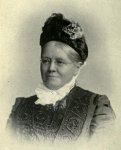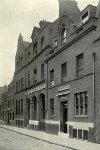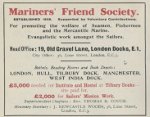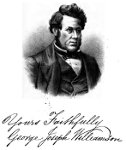

Non-denominational missions
<<
Dissenters
& Nonconformists (1) |
<< Dissenters
& Nonconformists (2) | << Dissenters
& Nonconformists (3)
 The moving force in this work among women and vulnerable girls in the area was
Miss Mary H. Steer [left] who was inspired by Ellice Hopkins (1836-1904) to
live and work here, coming in 1879. As she later wrote, in a paper on Rescue Work by
Women among Women in a collection edited by Baroness
Burdett-Coutts [p149], without this
merging of our lives into theirs, and a serious and practical study of
the world in which these poor degraded ones live, we shall never make
the headway we desire in saving that are called the 'lapsed classes' ...
casual visiting among the poor is so often of such little avail in
spite of well-meaning efforts. She was assisted in the early years by Miss
Allen, an archdeacon's daughter, until she went as a missionary to
Japan but died there within a few years. She was always clear that her work was 'Christian
but undenominational'.
The moving force in this work among women and vulnerable girls in the area was
Miss Mary H. Steer [left] who was inspired by Ellice Hopkins (1836-1904) to
live and work here, coming in 1879. As she later wrote, in a paper on Rescue Work by
Women among Women in a collection edited by Baroness
Burdett-Coutts [p149], without this
merging of our lives into theirs, and a serious and practical study of
the world in which these poor degraded ones live, we shall never make
the headway we desire in saving that are called the 'lapsed classes' ...
casual visiting among the poor is so often of such little avail in
spite of well-meaning efforts. She was assisted in the early years by Miss
Allen, an archdeacon's daughter, until she went as a missionary to
Japan but died there within a few years. She was always clear that her work was 'Christian
but undenominational'.  In
1888 a new Refuge and Night Shelter was opened in Betts Street [right] at a cost of
£4,000 by Adeline, Marchioness of Tavistock (later the Duchess of
Bedford), who was a keen supporter of her work.
The night shelter catered for destitute women, and was able to accommodate 18 women. The
team also conducted 'rescue work among fallen women', and 'preventive' [sic]
work with girls. They established a servants' lodge (accommodating nine) for girls out of place who have passed through the home (room for 9), and a mother and baby home (for seven mothers), both in Wlathamstow - both financed by two ladies. In due course there were five children's homes, in outer London, to
which referrals could me made. And they had 'industrial branches', teaching needle-work, dressmaking and knitting (including machine knitting).
In
1888 a new Refuge and Night Shelter was opened in Betts Street [right] at a cost of
£4,000 by Adeline, Marchioness of Tavistock (later the Duchess of
Bedford), who was a keen supporter of her work.
The night shelter catered for destitute women, and was able to accommodate 18 women. The
team also conducted 'rescue work among fallen women', and 'preventive' [sic]
work with girls. They established a servants' lodge (accommodating nine) for girls out of place who have passed through the home (room for 9), and a mother and baby home (for seven mothers), both in Wlathamstow - both financed by two ladies. In due course there were five children's homes, in outer London, to
which referrals could me made. And they had 'industrial branches', teaching needle-work, dressmaking and knitting (including machine knitting).| He hoped no one would think, because of the recent outrages [the Jack the Ripper murders], that matters were worse than they were some time ago. He could speak of Whitechapel and Spitalfields, and he did not hesitate to say the condition of things there was very much better than it was ten years ago. He would tell them what made it much worse than it was, what undid a great deal of good work that had been done and was being done - that was an enormous influx of inexperienced workers, who came down to the East End, stood in the way of those who knew the work, and were doing it to the best of their ability, wasted a great deal of money, dried up the springs of charity, and then, because they did not succeed, as most surely they would not succeed, discredited all such enterprise before those who must be looked to for material assistance. He hoped to see the day when every district in the East end would have some such institution as this connected with it, because by means of such agencies they would be able to do a great deal for the rescue of the lost. |
| Sir, My attention has just been called to Mr. Walter Hazell's letter in Saturday's issue of The Times. Nine years ago I came to live in Ratcliff Highway with the simple determination to find out how best to help that class of poor, miserable women whose mode of living has been so prominently brought forward by the horrible events of the past few weeks. During all this time I have been able to keep an open door for them, and with my fellow helpers have been learning, as we could only learn by experience, how most wisely and effectively to help those who come to us. The work has been very quietly carried on, but our houses have always been full to overflowing, and while hundreds of young girls and children have been rescued from the most dangerous surroundings, trained as little servants, emigrated to the colonies, and in other ways given a fair start in life, still many more from among the fallen have found our home a "bridge of hope" by which they have passed on to better things. The revelation of existence in Whitechapel lodging houses and in the streets of our great city must not simply evoke words of commiseration or be allowed to die out as a nine days' wonder, but must surely result in very practical measures being adopted for permanently benefitting those at least who are willing to be helped. Hundreds of women in this sad East end lead their degraded lives of sin for daily bread, or to secure a night's shelter in a fourpenny lodging house, a fact of which none can now plead ignorance, for the horrors of a few weeks (to our shame as a nation be it said) have brought out in awful relief the conditions under which so many of our fellow creatures exist, and which, though told persistently and without exaggeration by East end workers, have made but little impression. Finding that the missing link in the work in Ratcliff Highway was a night shelter, we have, during the past year, built one as a wing to our new refuge, and this will be opened on the 30th inst. by the Bishop of Bedford, although circumstances have compelled us already to give shelter in it to many who needed immediate help. Night shelters, answering only the purposes of a casual ward, may be the means of as much harm as good, but, managed with judicious discrimination and constant personal supervision, I believe that our "bridge of hope" night shelter will be an effectual means of helping not only those who have fallen but of saving very many friendless young girls from utter despair, when they come to their last resources. At this moment the strain of the work is very great. While people are devising, and very rightly so, how best to organise new methods and larger schemes, it sometimes appears that those who have been plodding on in the midst of the misery, and who have to bear the brunt of sudden emergencies, are apt to be forgotten, and however unwillingly we do so, it seems right to call attention to our present need of financial help. We are always thankful to see visitors, or to send reports if desired. Apologising for taking up so much of your valuable space, I am, Sir, yours faithfully, Mary H. Steer, Hon. Supt., Ratcliff Highway Refuge, St. George's in the East, London, E. |
| Rescue cases |
Preventive cases |
TOTAL |
Night shelter |
|
| 1880-81 |
110 |
37 |
147 |
|
| 1881-82 |
131 |
26 |
157 |
|
| 1882-83 |
183 |
59 |
242 |
|
| 1883-84 |
221 |
85 |
306 |
|
| 1884-85 |
273 |
93 |
366 |
|
| 1885-86 |
274 |
125 |
399 |
1738 |
| 1886-87 |
287 |
135 |
422 |
1007 |
| 1887-88 |
204 |
93 |
297 |
1027 |
| 1888-89 |
265 |
122 |
287 |
6072 [new premises] |
| 1898-90 |
222 |
182 |
404 |
5855 |
| 1890-91 |
254 |
176 |
430 |
5201 |
 Mariners' Friends Society
Mariners' Friends Society Its
President was George Joseph Williamson FSA; a fisherman's son, born in
Rochester in 1816 and educated at a charity school, he had worked as an
errand boy for a milliner and dressmaker, then went to sea with his
father - they fished out of Ramsgate on his own boat. Converted to
Wesleyan Methodism by his wife, he became a Sunday School teacher and
tract distributor, holding meetings on his vessel. He assisted the Duke
of Northumberland in breeding oysters at Alnwick. His collection of
religious verse The Ship's Career, & Other Poems was published in 1870 and went through several editions.
Its
President was George Joseph Williamson FSA; a fisherman's son, born in
Rochester in 1816 and educated at a charity school, he had worked as an
errand boy for a milliner and dressmaker, then went to sea with his
father - they fished out of Ramsgate on his own boat. Converted to
Wesleyan Methodism by his wife, he became a Sunday School teacher and
tract distributor, holding meetings on his vessel. He assisted the Duke
of Northumberland in breeding oysters at Alnwick. His collection of
religious verse The Ship's Career, & Other Poems was published in 1870 and went through several editions.
 The Revd Thomas Rose Couch [right]
was born in Jubilee Street, Stepney in 1853 and the superintendent
chaplain of the Society for over 50 years until his
death at Bank House, 210 Commercial Road in 1921. His father Enos was
also a minister; previous generations were west country shipwrights. He
married Clara (Fanny) Geldard [left] at
St Mary Cable Street in 1877 - the rest of her family had emigrated to
Texas. She was an amateur operatic singer. By the time
of his death he was living with their daughter Ida Ethel Maud. Their
other
children were Una Marion Pierce (who lived to 100), Stanley and Pierce
Herbert Frank, the
last of whom emigrated to New Zealand in 1920. Una's husband
Frank Woods, managing director of a City firm, was the sole executor of
Couch's will, which oddly described as a shipbroker living at 36 Lime Street; he left £434 4s 6d.
A memorial plaque
has recently been found, and an appropriate home is being sought for
it. The Booth archive contains an 1989 interview with Couch, and
a token for a free breakfast at the Seamen's Bethel!
The Revd Thomas Rose Couch [right]
was born in Jubilee Street, Stepney in 1853 and the superintendent
chaplain of the Society for over 50 years until his
death at Bank House, 210 Commercial Road in 1921. His father Enos was
also a minister; previous generations were west country shipwrights. He
married Clara (Fanny) Geldard [left] at
St Mary Cable Street in 1877 - the rest of her family had emigrated to
Texas. She was an amateur operatic singer. By the time
of his death he was living with their daughter Ida Ethel Maud. Their
other
children were Una Marion Pierce (who lived to 100), Stanley and Pierce
Herbert Frank, the
last of whom emigrated to New Zealand in 1920. Una's husband
Frank Woods, managing director of a City firm, was the sole executor of
Couch's will, which oddly described as a shipbroker living at 36 Lime Street; he left £434 4s 6d.
A memorial plaque
has recently been found, and an appropriate home is being sought for
it. The Booth archive contains an 1989 interview with Couch, and
a token for a free breakfast at the Seamen's Bethel!<< Dissenters & Nonconformists (1) | << Dissenters & Nonconformists (2) << Dissenters & Nonconformists (3) | History